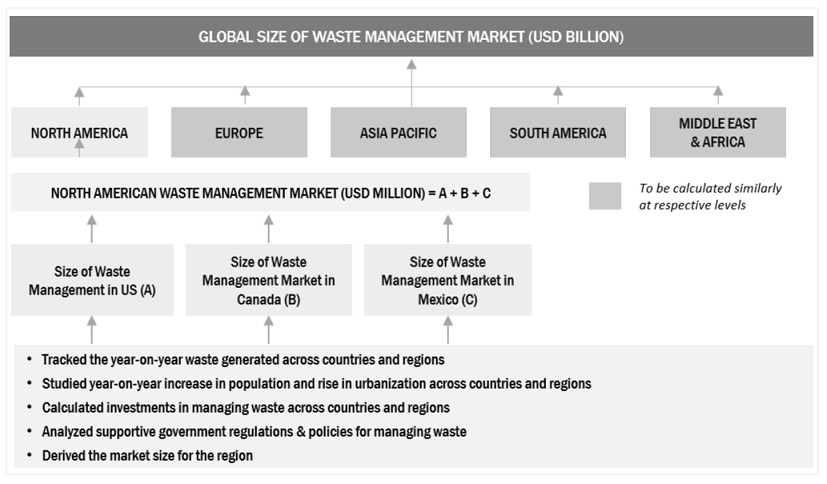The global waste management market size is projected to reach USD 542.7 billion by 2026 from an estimated value of USD 423.4 billion in 2021, growing at a CAGR of 5.1%. Stringent regulations of governments worldwide for better management of waste and initiate environmental protection; strong focus of several governments to conduct awareness programs showcasing importance of waste segregation and waste management; technological advances and shortened life cycle of electronic products help in increasing e-waste are the key factors driving the waste management market.
Key Market Players:
The waste management market is dominated by major players that are established brand names with an extensive regional presence, along with many local and regional players in emerging economies. The key players in the waste management market include companies such Waste Management (US), Veolia (France), Republic Services (US), SUEZ (France), and Waste Connections (US).
Download PDF Brochure – https://www.marketsandmarkets.com/pdfdownloadNew.asp?id=72285482
The E-waste segment by waste type is estimated to be the largest market for waste management, from 2021 to 2026. The growth of the wired segment is driven by the rapid urbanization, transforming urban mobility, and increased need to reduce carbon emissions. The market for the e-waste segment in Asia Pacific is expected to grow at the highest CAGR during the forecast period. E-waste includes electrically powered component waste. They include appliances such as computers, consumer electronics, and refrigerators. E-waste is a mixture of useful and hazardous materials that demand careful handling and recycling of materials. Thus, e-waste management has gained importance globally to secure the environment from the adverse effects of the materials such as lead and plastics.

According on service type, the recycling segment is expected to grow at the fastest CAGR from 2021 to 2026. The growth of this segment is driven owing to high essentiality to reduce greenhouse gas emission. Recycling, recovery, and reprocessing of waste materials are useful to produce new products. The basic phases in recycling are the collection of waste materials, their processing into new products, and purchasing of those products, which may then themselves be recycled. Typical materials that can be recycled are iron and steel scraps, aluminum cans, glass bottles, paper, wood, and plastics. The materials reused in recycling serve as substitutes for raw materials obtained from such increasingly scarce natural resources as petroleum, natural gas, coal, mineral ores, and trees. Recycling can help reduce the quantities of solid waste deposited in landfills, which has become increasingly expensive. Recycling also reduces the pollution of air, water, and land, resulting from waste disposal. Recycling helps reduce energy usage, decrease the amount of new/fresh raw materials, and minimize greenhouse gas emissions.
The waste management market has been segmented, by region, into North America, Europe, Asia Pacific, the Middle East & Africa, and South America. The Asia Pacific region is projected to grow at the fastest rate, from 2021 to 2026, followed by Europe. The region has been segmented, by country, into China, Japan, India, Australia, South Korea, and Rest of Asia Pacific. Rest of Asia Pacific mainly includes Singapore, Malaysia, Thailand, and Indonesia. The population growth in the region, the high disposable income of the people, and the increased demand for packaged food products are among a few major factors that drive the growth of waste management in the region. Asia Pacific is also a key contributor to marine plastic pollution. The materials involved include plastic bottles, plastic bags, single-use plastic items, and plastic packaging, among others. Key countries responsible for this kind of pollution include China, Indonesia, and Thailand.
Ask Sample Pages – https://www.marketsandmarkets.com/requestsampleNew.asp?id=72285482
Report Objectives
- To define, describe, waste management market, based on waste type, service type, and end user
- To provide detailed information on the major factors influencing the growth of the market (drivers, restraints, opportunities, and industry-specific challenges)
- To strategically analyze the market with respect to individual growth trends, prospects, and contribution of each segment to the market
- To analyze the impact of COVID-19 on the market for the estimation of the market size
- To analyze market opportunities for stakeholders and details of a competitive landscape for market leaders
- To forecast the growth of the market with respect to the major regions (Asia Pacific, Europe, North America, South America, the Middle East, & Africa)
- To strategically profile key players and comprehensively analyze their market share and core competencies
- To track and analyze competitive developments, such as new product launches, contracts, agreements, investments & expansions, and mergers & acquisitions, in the waste management market
